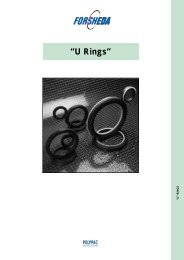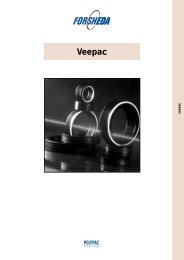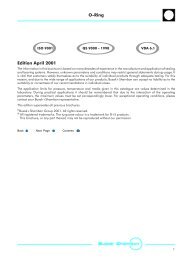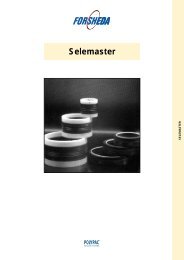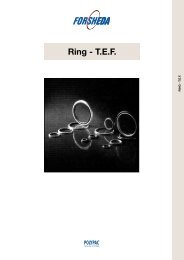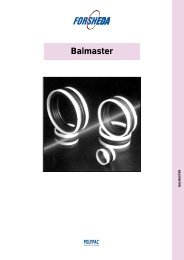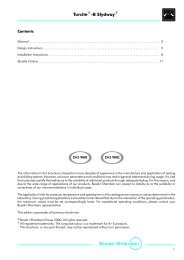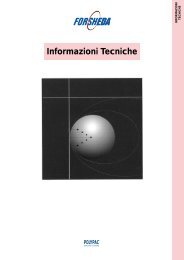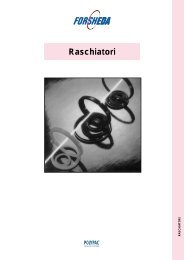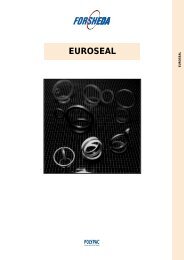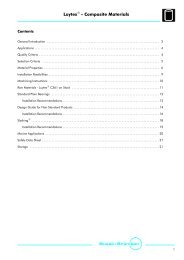Rotary Seals - Dilanda.it
Rotary Seals - Dilanda.it
Rotary Seals - Dilanda.it
Create successful ePaper yourself
Turn your PDF publications into a flip-book with our unique Google optimized e-Paper software.
Cassette Seal<br />
System 5000<br />
The System 5000 seal must be installed onto a shaft or a<br />
sleeve by a special assembly tool. The seal shall be oriented<br />
w<strong>it</strong>h the side marked “oil side“ facing the inside of the<br />
gearbox. The shaft must then be assembled so the oil side<br />
of the seal is entering the housing bore.<br />
If the shaft is hollow, the assembly tool should be designed<br />
w<strong>it</strong>h a guiding column.<br />
For pinion applications on trucks, when a separate end<br />
carrier is used, the seal is simply pressed onto the end<br />
carrier in a first step of assembling. The end carrier is then<br />
entering the splines on the pinion shaft and then a locking<br />
nut is used to drive the end carrier and the seal into the<br />
right pos<strong>it</strong>ion.<br />
The force required to assemble a System 5000 seal onto the<br />
shaft is between 20 to 50 kN, while assembly into the<br />
housing bore requires about 1.0 kN. The value of assembly<br />
force depends on surface structure for shaft resp. housing<br />
bore as well as the tolerances. It is recommended to oil the<br />
outer rubber covered surface of the seal and also the<br />
housing bore, to decrease the force necessary for assembly.<br />
During the start-up phase, eventually some leakage of<br />
grease and smoke formation may occur. This is a result of<br />
the generation of frictional heat between the metal cases<br />
and the support lugs of rubber, and does not influence on<br />
the function and service life of the seal.<br />
Storage<br />
As the service life of bearings and other machine parts<br />
depends on how well the seals perform, seals should be<br />
handled w<strong>it</strong>h caution. Unfavourable storage cond<strong>it</strong>ions or<br />
improper handling will most likely lead to a change of their<br />
physical properties. This can lead to a shortening of life, or<br />
failure, for example as a result of hardening or softening,<br />
cracking or other surface damages. These changes can be<br />
the result of one particular factor or a combination of<br />
factors, like oxygen, ozone, heat, light, moisture, solvents<br />
etc. Storing the seals under load can lead to permanent<br />
deformation of the elastomer. On the other hand, properly<br />
stored elastomer products retain their properties for<br />
several years.<br />
As the sens<strong>it</strong>ive sealing lips and counter faces are well<br />
protected inside the Cassette seal casing, there is less risk of<br />
mechanical damages and influence of dirt and dust in<br />
comparison to many other seal types.<br />
Cleaning<br />
If cleaning of Cassette seals is necessary, use a damp duster<br />
and allow the seals to dry off at room temperature.<br />
Solvents, sharp-edged objects and abrasives should not be<br />
used.<br />
If the seal is jammed or damaged in some way during<br />
installation, the seal must be replaced before start up.<br />
If the construction is disassembled for any reason, a new<br />
seal should be installed.<br />
Further instructions for assembling can be found on<br />
separate assembly instruction sheets available from your<br />
local B+S office.<br />
Dismantling and replacement<br />
As all the necessary functions are integrated in the Cassette<br />
seal the complete sealing arrangement is re-newed. The<br />
shaft to be sealed is unaffected by wear and once <strong>it</strong> has<br />
been cleaned and possible corrosion and dirt have been<br />
removed a new seal can be f<strong>it</strong>ted again.<br />
The Cassette Seal may be provided w<strong>it</strong>h a sealant on the<br />
metal casing when <strong>it</strong> is installed into the housing. Take care<br />
that the sealant do not flow into the seal or is smeared<br />
onto the rubber surface as this may impede the function of<br />
the seal. The sealant can reduce the risk of static leakage<br />
due to small imperfections on the surface.<br />
Latest information available at www.busakshamban.com<br />
Ed<strong>it</strong>ion April 2006<br />
143



